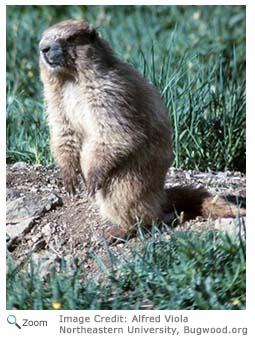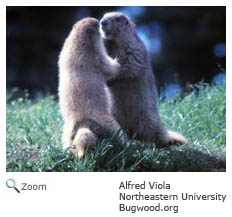Characteristics
 The Olympic marmot has brown fur mixed with white. Patches of its fur may lighten to a light brown in the summer. It has a white muzzle, small ears and eyes, a bushy tail and short legs. The Olympic marmot has sharp claws that it uses for digging. The Olympic marmot has brown fur mixed with white. Patches of its fur may lighten to a light brown in the summer. It has a white muzzle, small ears and eyes, a bushy tail and short legs. The Olympic marmot has sharp claws that it uses for digging.
Range
 The Olympic marmot can be found in the Olympic Mountains in Washington state. The Olympic marmot can be found in the Olympic Mountains in Washington state. |
|
Habitat
The Olympic marmot can be found on rocky mountain slopes and hillsides and in alpine meadows.
Diet
The Olympic marmot eats a variety of grasses, flowers and green plants including sedges, lupines, mosses, lilies and heather blossoms. Occasionally, it eats insects. It hibernates from September through May. After it comes out of hibernation, roots make up a large part of its diet until new plants bloom.
Life Cycle
The Olympic marmot mates a couple of weeks after it comes out of hibernation. About a month after mating, the female gives birth to four to five babies. The young stay with their family group for at least two years. Female Olympic marmots usually have a litter every other year.
Behavior
 The Olympic marmot is active in the day. It feeds in the morning and afternoon. When it is not feeding, it spends its time sunning itself on rocks. It retreats to its burrow at night.
 The Olympic marmot is very social. It lives in family groups made up of one male, two or three females, a litter of year-old marmots and the new litter. Males mate with one female one year and another female the next year. Family members greet each other by touching noses. They also groom each other. The Olympic marmot is very social. It lives in family groups made up of one male, two or three females, a litter of year-old marmots and the new litter. Males mate with one female one year and another female the next year. Family members greet each other by touching noses. They also groom each other.
|